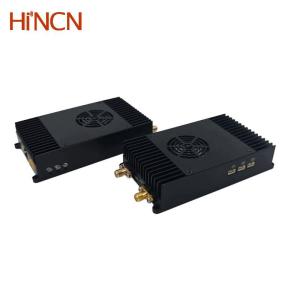

Add to Cart
20km-100km Drone Video Transmitter COFDM Duplex IP Video Data Transceiver
Key Features:
Product Overview:
HCL536 Drone Video Transmitter was designed for video and data wireless transmission with two- way wireless data link. This OFDM radio link works at 800MHz or 1.4GHz bands, with frequency hopping technology (FHSS) to make sure better stability signal communication.
Specifications:
| 20km-100km Drone Video Transmitter COFDM Duplex IP Video Data Transceiver | |
| Modulation | TDD OFDM |
| Frequency | 806~826MHz,1428~1468MHz,1420~1530MHz |
| FHSS | Support |
| Bandwidths | 1.4/3/5/10/20MHz |
| Throughput | Maximum 30Mbps@20MHz |
| RF Transmissioin Power | 2W or 5W |
| Constellation | QPSK,16QAM,64QAM self adaption |
| Sensitivity | -108dBm(1Mbps) |
| Ethernet ports | 2 * Ethernet ports |
| Serial ports | 3 channels,3*RS232, 3*TTL or 2*RS232/ TTL+ 1*Sbus |
| Transmission Range | 22~100km (UAV to Ground) |
| Management | Web UI and Control Uart |
| Encryption | AES128 |
| Networking Mode | Point to Point, Point to Multipoint,Relay, Mesh |
| Movement Speed | Support no less than 300km/h |
| Power Input | 12~18V(2W), 24~28V(5W) |
| Power Consumption | <12W(RF Power 2W), <22W(RF Power 5W) |
| Dimensions | 103.4*61.4*22mm |
| Weight | 142g |
| Input/Output | Description |
| Ethernet 1 | 4Pin ZH1.5mm connector, bridged with Ethernet2 |
| Ethernet 2 | RJ45 connector, bridged with Ethernet1 |
| Uart *3 | 3Pin GH1.25mm lockable connector*3, 3 channel uart, RS232/TTL/Sbus optional |
| Power in | XT30PW-M connector |
| ANT1 | Tx/Rx Antenna port, SMA female |
| ANT2 | Rx Antenna port, SMA female |
Wireless Networking with HCL536:
HCL536 drone video transmitter supports two operating modes: Access Node or Central Node. It can be managed through web UI. HCL536 supports features of maximum 16 Access Nodes connected to a Central Node. All of the Nodes are in a same wireless LAN and share the whole transmission bandwidth (maximum 30Mbps@20MHz throughput). Data from Central Node to Access Node, we call downlink, and data from Access Node to Central Node, we call uplink. Uplink and downlink stream ratio can be controlled through web UI. When using HCL536 for Point-to-Point transmitting, uplink and downlink share the whole transmission bandwidth (maximum 30Mbps@20MHz throughput) too. HCL536 supports networking mode: Point -to-Point, Point-to-Multipoint, Relay, and Mesh (specify mesh version when order).
Point-to-Point networking type:
Point to Multipoint networking type
Relay networking type
Mesh networking type (Specify)
Application:
FAQ
Q1. This drone video transmitter seems to support IP camera, what if I want to use a camera with HDMI or SDI video output?
A: Yes, the default video input is IP RJ45 Ethernet port, if your camera only has HDMI, SDI, AHD or AV output, you need to buy our mini encoder device to encode the video and audio signal into digital data for transmission. At the receiver end, you can connect it directly to your computer or NVR. If you want to output to an HDMI monitor, you can also buy our decoder device to convert the digital data back into HDMI video and audio signals.
Q2. Should I choose 800MHz or 1.4G band? Which one is better?
A: If your area has a DVB-T or DVB-T2 digital television signal, the TV frequency range is 170-860Mhz, so choose 1.4G would be better. Moreover, GPS antenna receives the GPS signal and the GPS direction on the drone is up, and our transmitter antenna is pointing down to send the signal to the ground. So the 1.4G frequency effect on GPS is negligible.
Q3. Does it support using multiple cameras on the transmitter to only one receiver? For example, use 3 IP cameras on the transmitter.
A: Yes, it supports. There are two solutions for the multiple cameras on transmitter to one receiver.
1. 4 IP cameras -> Net Hub -> Transmitter <===> Receiver -> Computer Screen
2. 4 IP cameras -> NVR HDMI output -> HDMI encoder IP output -> Transmitter <===> Receiver -> computer screen.
Q4. Does the transmitter on the air give failsafe command to the flight controller when the connection between air and ground will be lost?
A: The serial port of our wireless video transmission link is transparent, no data is actively sent to the flight controller. This is controlled by the ground station. It won't send failsafe command, but you can see the link working status led from the signal indicator as below:
| Link LED | Wireless link status |
| No light | This node is not connected with the wireless network |
| Red light | The wireless link signal is weak |
| Orange light | The wireless link signal is in middle |
| Green light | The wireless link signal is strong |
Flight controller doesn't get the information, but you can see the link status LED light, if it is Orange or Red, you should control the UAV back in advance. You can also get the RSSI values from below window:
Q5. Can the air unit and ground unit be interchanged for use with change in the setting?
A:The difference between the air unit (transmitter) and ground unit (receiver) is:
